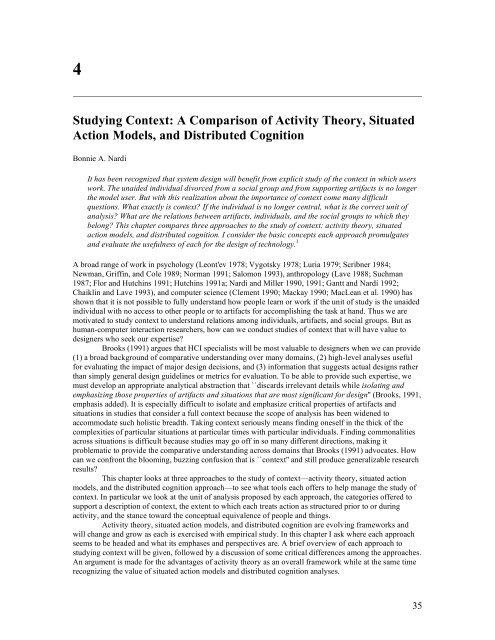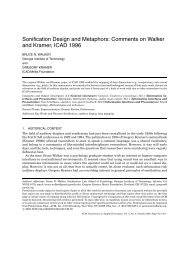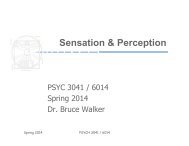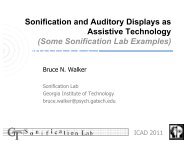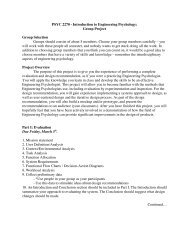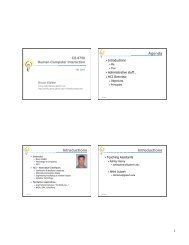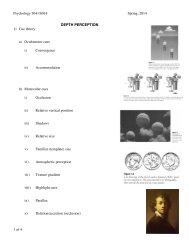Studying Context: A Comparison of Activity Theory, Situated Action ...
Studying Context: A Comparison of Activity Theory, Situated Action ...
Studying Context: A Comparison of Activity Theory, Situated Action ...
Create successful ePaper yourself
Turn your PDF publications into a flip-book with our unique Google optimized e-Paper software.
4<strong>Studying</strong> <strong>Context</strong>: A <strong>Comparison</strong> <strong>of</strong> <strong>Activity</strong> <strong>Theory</strong>, <strong>Situated</strong><strong>Action</strong> Models, and Distributed CognitionBonnie A. NardiIt has been recognized that system design will benefit from explicit study <strong>of</strong> the context in which userswork. The unaided individual divorced from a social group and from supporting artifacts is no longerthe model user. But with this realization about the importance <strong>of</strong> context come many difficultquestions. What exactly is context? If the individual is no longer central, what is the correct unit <strong>of</strong>analysis? What are the relations between artifacts, individuals, and the social groups to which theybelong? This chapter compares three approaches to the study <strong>of</strong> context: activity theory, situatedaction models, and distributed cognition. I consider the basic concepts each approach promulgatesand evaluate the usefulness <strong>of</strong> each for the design <strong>of</strong> technology. 1A broad range <strong>of</strong> work in psychology (Leont'ev 1978; Vygotsky 1978; Luria 1979; Scribner 1984;Newman, Griffin, and Cole 1989; Norman 1991; Salomon 1993), anthropology (Lave 1988; Suchman1987; Flor and Hutchins 1991; Hutchins 1991a; Nardi and Miller 1990, 1991; Gantt and Nardi 1992;Chaiklin and Lave 1993), and computer science (Clement 1990; Mackay 1990; MacLean et al. 1990) hasshown that it is not possible to fully understand how people learn or work if the unit <strong>of</strong> study is the unaidedindividual with no access to other people or to artifacts for accomplishing the task at hand. Thus we aremotivated to study context to understand relations among individuals, artifacts, and social groups. But ashuman-computer interaction researchers, how can we conduct studies <strong>of</strong> context that will have value todesigners who seek our expertise?Brooks (1991) argues that HCI specialists will be most valuable to designers when we can provide(1) a broad background <strong>of</strong> comparative understanding over many domains, (2) high-level analyses usefulfor evaluating the impact <strong>of</strong> major design decisions, and (3) information that suggests actual designs ratherthan simply general design guidelines or metrics for evaluation. To be able to provide such expertise, wemust develop an appropriate analytical abstraction that ``discards irrelevant details while isolating andemphasizing those properties <strong>of</strong> artifacts and situations that are most significant for design'' (Brooks, 1991,emphasis added). It is especially difficult to isolate and emphasize critical properties <strong>of</strong> artifacts andsituations in studies that consider a full context because the scope <strong>of</strong> analysis has been widened toaccommodate such holistic breadth. Taking context seriously means finding oneself in the thick <strong>of</strong> thecomplexities <strong>of</strong> particular situations at particular times with particular individuals. Finding commonalitiesacross situations is difficult because studies may go <strong>of</strong>f in so many different directions, making itproblematic to provide the comparative understanding across domains that Brooks (1991) advocates. Howcan we confront the blooming, buzzing confusion that is ``context'' and still produce generalizable researchresults?This chapter looks at three approaches to the study <strong>of</strong> context—activity theory, situated actionmodels, and the distributed cognition approach—to see what tools each <strong>of</strong>fers to help manage the study <strong>of</strong>context. In particular we look at the unit <strong>of</strong> analysis proposed by each approach, the categories <strong>of</strong>fered tosupport a description <strong>of</strong> context, the extent to which each treats action as structured prior to or duringactivity, and the stance toward the conceptual equivalence <strong>of</strong> people and things.<strong>Activity</strong> theory, situated action models, and distributed cognition are evolving frameworks andwill change and grow as each is exercised with empirical study. In this chapter I ask where each approachseems to be headed and what its emphases and perspectives are. A brief overview <strong>of</strong> each approach tostudying context will be given, followed by a discussion <strong>of</strong> some critical differences among the approaches.An argument is made for the advantages <strong>of</strong> activity theory as an overall framework while at the same timerecognizing the value <strong>of</strong> situated action models and distributed cognition analyses.35
Attention to the shaping force <strong>of</strong> goals in activity theory and distributed cogntion, be theyconscious human motives or systemic goals, contrasts with the contingent, responsive, improvisatoryemphasis <strong>of</strong> situated action. In situated action, one activity cannot be distinguished from another byreference to an object (motive); in fact Lave (1988) argues that ``goals [are not] a condition for action.... Ananalytic focus on direct experience in the lived-in world leads to ... the proposition that goals areconstructed, <strong>of</strong>ten in verbal interpretation'' (emphasis in original). In other words, goals are our musings outloud about why we did something after we have done it; goals are ``retrospective and reflexive'' (Lave1988).In a similar vein, Suchman (1987), following Garfinkel (1967), asserts that ``a statement <strong>of</strong> intentgenerally says very little about the action that follows.'' If we appear to have plans to carry out our intent, itis because plans are ``an artifact <strong>of</strong> our reasoning about action, not ... the generative mechanism <strong>of</strong> action.''(emphasis in original). Suchman (1987) says that plans are ``retrospective reconstructions.'' 6 The positionadopted by Lave (1988) and Suchman (1987) concerning goals and plans is that they are post hocrationalizations for actions whose meaning can arise only within the immediacy <strong>of</strong> a given situation.Lave (1988) asks the obvious question about this problematic view <strong>of</strong> intentionality: ``If themeaning <strong>of</strong> activity is constructed in action ... from whence comes its intentional character, and indeed itsmeaningful basis?'' Her answer, that ``activity and its values are generated simultaneously,'' restates herposition but does not explicate it. Winograd and Flores (1986) also subscribe to this radically situated view,using the colorful term ``throwness'' (after Heidegger) to argue that we are actively embedded, or ``throwninto,'' in an ongoing situation that directs the flow <strong>of</strong> our actions much more than reflection or the use <strong>of</strong>durable mental representations.In activity theory and distributed cognition, by contract, an object-goal is the beginning point <strong>of</strong>analysis. An object precedes and motivates activity. As Leont'ev (1974) states, ``Performing operations thatdo not realize any kind <strong>of</strong> goal-directed action [and recursively, a motive] on the subject's part is like theoperation <strong>of</strong> a machine that has escaped human control.''In activity theory and distributed cognition, an object is (partially) determinative <strong>of</strong> activity; insituated action, every activity is by definition uniquely constituted by the confluence <strong>of</strong> the particularfactors that come together to form one ``situation.'' In a sense, situated action models are confined to whatactivity theorists would call the action and operation levels (though lacking a notion <strong>of</strong> goal at the actionlevel in the activity theory sense). <strong>Situated</strong> action concentrates, at these levels, on the way people orient tochanging conditions. Suchman's (1987) notion <strong>of</strong> ``embodied skills'' is similar to the notion <strong>of</strong> operations,though less rich than the activity theory construct which grounds operations in consciousness and specifiesthat operations are dependent on certain conditions obtaining and that they may dynamically transform intoactions when conditions change.While in principle one could reasonably focus one's efforts on understanding the action andoperation levels while acknowledging the importance <strong>of</strong> the object level, neither Lave (1988) nor Suchman(1987), as we have seen, does this. On the contrary, the very idea <strong>of</strong> an object's generating activity isrejected; objects (goals) and plans are ``retrospective reconstructions,'' post hoc ``artifacts <strong>of</strong> reasoningabout action,'' after action has taken place. Why people would construct such explanations is an interestingquestion not addressed in these accounts. And why other people would demand or believe suchretrospective reconstructions is another question to be addressed by this line <strong>of</strong> reasoning.<strong>Situated</strong> action models have a slightly behavioristic undercurrent in that it is the subject's reactionto the environment (the ``situation'') that finally determines action. What the analyst observes is cast as aresponse (the subject's actions/operations) to a stimulus (the ``situation''). The mediating influences <strong>of</strong>goals, plans, objects, and mental representations that would order the perception <strong>of</strong> a situation are absent inthe situated view. There is no attempt to catalog and predict invariant reactions (as in classical behaviorism)as situations are said to vary unpredictably, but the relation between actor and environment is one <strong>of</strong>reaction in this logic. 7 People ``orient to a situation'' rather than proactively generating activity rich withmeaning reflective <strong>of</strong> their interests, intentions, and prior knowledge.Suchman and Trigg (1991) cataloged their research methods in describing how they conductempirical studies. What is left out is as interesting as what is included. The authors report that they use (1) astationary video camera to record behavior and conversation; (2) ``shadowing'' or following around anindividual to study his or her movements; (3) tracing <strong>of</strong> artifacts and instrumenting <strong>of</strong> computers to auditusage, and (4) event-based analysis tracking individual tasks at different locations in a given setting. Absentfrom this catalog is the use <strong>of</strong> interviewing; interviews are treated as more or less unreliable accounts <strong>of</strong>idealized or rationalized behavior, such as subjectively reported goals as ``verbal interpretation'' (Lave40
(1974) (following work by Vygotsky) considered the use <strong>of</strong> tools to be crucial: ``A tool mediates activitythat connects a person not only with the world <strong>of</strong> objects, but also with other people. This means that aperson's activity assimilates the experience <strong>of</strong> humanity.'' Distributed cognition <strong>of</strong>fers a similar notion; forexample, Hutchins (1987) discusses ``collaborative manipulation,'' the process by which we take advantage<strong>of</strong> artifacts designed by others, sharing good ideas across time and space. Hutchins's example is a navigatorusing a map: the cartographer who created the map contributes, every time the navigator uses the map, to aremote collaboration in the navigator's task.<strong>Situated</strong> action models less readily accommodate durable structures that persist over time andacross different activities. To the extent that activity is truly seen as ``situated,'' persistent, durablestructures that span situations, and can thus be described and analyzed independent <strong>of</strong> a particularsituation, will not be central. It is likely, however, that situated action models, especially those concernedwith the design <strong>of</strong> technology, will allow some latitude in the degree <strong>of</strong> adherence to a purist view <strong>of</strong>situatedness, to allow for the study <strong>of</strong> cognitive and structural properties <strong>of</strong> artifacts and practices as theyspan situations. Indeed, in recent articles we find discussion <strong>of</strong> ``routine practices'' (Suchman and Trigg1991) and ``routine competencies'' (Suchman 1993) to account for the observed regularities in the worksettings studied. The studies continue to report detailed episodic events rich in minute particulars, butweave in descriptions <strong>of</strong> routine behavior as well.<strong>Situated</strong> action accounts may then exhibit a tension between an emphasis on that which isemergent, contingent, improvisatory and that which is routine and predictable. It remains to be seen justhow this tension resolves—whether an actual synthesis emerges (more than simple acknowledgment thatboth improvisations and routines can be found in human behavior) or whether the claims to truesituatedness that form the basis <strong>of</strong> the critique <strong>of</strong> cognitive science cede some importance to representations``in the head.'' The appearance <strong>of</strong> routines in situated action models opens a chink in the situated armorwith respect to mental representations; routines must be known and represented somehow. Routines stillcircumambulate notions <strong>of</strong> planful, intentional behavior; being canned bits <strong>of</strong> behavior, they obviate theneed for active, conscious planning or the formulation <strong>of</strong> deliberate intentions or choices. Thus the positing<strong>of</strong> routines in situated action models departs from notions <strong>of</strong> emergent, contingent behavior but isconsistent in staying clear <strong>of</strong> plans and motives.Of the three frameworks, distributed cognition has taken most seriously the study <strong>of</strong> persistentstructures, especially artifacts. The emphasis on representations and the transformations they undergobrings persistent structures to center stage. Distributed cognition studies provide in-depth analyses <strong>of</strong>artifacts such as nomograms (Norman and Hutchins 1988), navigational tools (Hutchins 1990), airplanecockpits (Hutchins 1991a), spreadsheets (Nardi and Miller 1990, 1991), computer-aided design (CAD)systems (Petre and Green 1992), and even everyday artifacts such as door handles (Norman 1988). In theseanalyses, the artifacts are studied as they are actually used in real situations, but the properties <strong>of</strong> theartifacts are seen as persisting across situations <strong>of</strong> use, and it is believed that artifacts can be designed orredesigned with respect to their intrinsic structure as well as with respect to specific situations <strong>of</strong> use. Forexample, a spreadsheet table is an intrinsically good design (from a perceptual standpoint) for a system inwhich a great deal <strong>of</strong> dense information must be displayed and manipulated in a small space (Nardi andMiller 1990). Hutchins's (1991a) analysis <strong>of</strong> cockpit devices considers the memory requirements theyimpose. Norman (1988) analyzes whether artifacts are designed to prevent users from doing unintended(and unwanted) things with them. Petre and Green (1992) establish requirements for graphical notations forcomputer-aided design (CAD) users based on users' cognitive capabilities. In these studies, anunderstanding <strong>of</strong> artifacts is animated by observations made in real situations <strong>of</strong> their use, but there is alsoimportant consideration given to the relatively stable cognitive and structural properties <strong>of</strong> the artifacts thatare not bound to a particular situation <strong>of</strong> use.Distributed cognition has also been productive <strong>of</strong> analyses <strong>of</strong> work practices that span specificsituational contexts. For example, Seifert and Hutchins (1988) studied cooperative error correction onboard large ships, finding that virtually all navigational errors were collaboratively ``detected and correctedwithin the navigation team.'' Gantt and Nardi (1992) found that organizations that make intensive use <strong>of</strong>CAD s<strong>of</strong>tware may create formal in-house support systems for CAD users composed <strong>of</strong> domain experts(such as drafters) who also enjoy working with computers. Rogers and Ellis (1994) studied computermediatedwork in engineering practice. Symon et al. (1993) analyzed the coordination <strong>of</strong> work in aradiology department in a large hospital. Nardi et al. (1993) studied the coordination <strong>of</strong> work duringneurosurgery afforded by video located within the operating room and at remote locations in the hospital. Aseries <strong>of</strong> studies on end user computing have found a strong pattern <strong>of</strong> cooperative work among users <strong>of</strong> a42
the situation by virtue <strong>of</strong> prior interest and knowledge. She is constrained by the environment in importantways, but her actions are not determined by it. As Davydov, Zinchenko, and Talyzina (1982) put it, thesubject actively ```meets' the object with partiality and selectivity,'' rather than being ``totally subordinate tothe effects <strong>of</strong> environmental factors ... the principle <strong>of</strong> reactivity is counterposed to the principle <strong>of</strong> thesubject's activeness.''It is also important to remember that the walker has consciously chosen an object and taken thenecessary actions for carrying it out; she did not just suddenly and unexpectedly end up in the woods. Canwe really say, as Suchman (1987) does, that her actions are ``ad hoc''? <strong>Situated</strong> action analyses <strong>of</strong>tenassume a ``situation'' that one somehow finds oneself in, without consideration <strong>of</strong> the fact that the very``situation'' has already been created in part by the subject's desire to carry out some activity. For example,Suchman's famous canoeing example, intended to show that in the thick <strong>of</strong> things one abandons plans, isset up so that the ``situation'' is implicitly designated as ``getting your canoe through the falls'' (Suchman1987). Surely the deck is stacked here. What about all the plotting and planning necessary to get away forthe weekend, transport the canoe to the river, carry enough food, and so forth that must also be seen asdefinitive <strong>of</strong> the situation? It is only with the most mundane, plodding, and planful effort that one arrives``at the falls.'' To circumscribe the ``situation'' as the glamorous, unpredictable moment <strong>of</strong> running therapids is to miss the proverbial boat, as it were. An activity theory analysis instructs us to begin with thesubjectively defined object as the point <strong>of</strong> analytical departure and thus will lead not simply to crystallinemoments <strong>of</strong> improvisatory drama (whether measuring cottage cheese or running rapids) but to a moreglobal view that encompasses the totality <strong>of</strong> an activity construed and constructed, in part, prior to itsundertaking, with conscious, planful intent.Holland and Reeves (this volume) studied the differing paths taken by three groups <strong>of</strong> studentprogrammers all enrolled in the same class and all beginning in the same ``situation.'' The pr<strong>of</strong>essor gaveeach group the same specific task to accomplish during the semester and the students' ``performances wereeven monitored externally from an explicit and continually articulated position.'' The students were allsupposed to be doing the same assignment; they heard the same lectures and had the same readings andresources. But as Holland and Reeves document, the projects took radically different courses and hadextremely variable outcomes because the students themselves redefined the object <strong>of</strong> the class. Ourunderstanding <strong>of</strong> what happened here must flow from an understanding <strong>of</strong> how each group <strong>of</strong> studentsconstrued, and reconstrued, the class situation. The ``situation'' by itself cannot account for the fact that onegroup <strong>of</strong> students produced a tool that was chosen for demonstration at a pr<strong>of</strong>essional conference later inthe year; one group produced a program with only twelve lines <strong>of</strong> code (and still got an A!); and the thirdgroup ``became so enmeshed in [interpersonal struggles] that the relationships among its membersfrequently became the object <strong>of</strong> its work.''Bellamy (this volume) observes that to achieve practical results such as successfully introducingtechnology into the classroom, it is necessary to understand and affect the objects <strong>of</strong> educators: ``to changethe underlying educational philosophy <strong>of</strong> schools, designers must design technologies that support students'learning activities and design technologies that support the activities <strong>of</strong> educators and educationaladministrators. Only by understanding and designing for the complete situation <strong>of</strong> education ... will it bepossible for technology to bring about pervasive educational reform.''<strong>Situated</strong> action models make it difficult to go beyond the particularities <strong>of</strong> the immediate situationfor purposes <strong>of</strong> generalization and comparison. One immerses in the minutiae <strong>of</strong> a particular situation, andwhile the description may feel fresh, vivid, and ``on-the-ground'' as one reads it, when a larger task such ascomparison is attempted, it is difficult to carry the material over. One finds oneself in a claustrophobicthicket <strong>of</strong> descriptive detail, lacking concepts with which to compare and generalize. The lack <strong>of</strong>conceptual vocabulary, the appeal to the ``situation'' itself in its moment-by-moment details, do not lendthemselves to higher-order scientific tasks where some abstraction is necessary.It is appropriate to problematize notions <strong>of</strong> comparison and generalization in order to sharpencomparisons and generalizations, but it is fruitless to dispense with these foundations <strong>of</strong> scientific thought.A pure and radically situated view would by definition render comparison and generalization as logically atodds with notions <strong>of</strong> emergence, contingency, improvisation, description based on in situ detail and point<strong>of</strong> view. (I am not saying any <strong>of</strong> the situated theorists cited here are this radical; I am playing out the logicalconclusion <strong>of</strong> the ideas.) Difficult though it may be to compare and generalize when the subject matter ispeople, it is nonetheless important if we are to do more than simply write one self-contained descriptiveaccount after another. The more precise, careful, and sensitive comparisons and generalizations are, thebetter. This is true not only from the point <strong>of</strong> view <strong>of</strong> science but also <strong>of</strong> technology design. Design, a45
To summarize the practical methodological implications for HCI studies <strong>of</strong> what we have been discussingin this section, we see that activity theory implies:1. A research time frame long enough to understand users' objects, including, where appropriate,changes in objects over time and their relation to the objects <strong>of</strong> others in the setting studied. Kuutti(this volume) observes that ``activities are longer-term formations and their objects cannot betransformed into outcomes at once, but through a process consisting <strong>of</strong>ten <strong>of</strong> several steps or phases.''Holland and Reeves (this volume) document changing objects in their study <strong>of</strong> student programmers.Engeström and Escalante (this volume) trace changes in the objects <strong>of</strong> the designers <strong>of</strong> the PostalBuddy. Christiansen (this volume) shows how actions can become objectified, again a process <strong>of</strong>change over time.2. Attention to broad patterns <strong>of</strong> activity rather than narrow episodic fragments that fail to reveal theoverall direction and import <strong>of</strong> an activity. The empirical studies in this book demonstrate the methodsand tools useful for analyzing broad patterns <strong>of</strong> activity. Looking at smaller episodes can be useful, butnot in isolation. Bødker (this volume) describes her video analysis <strong>of</strong> episodes <strong>of</strong> use <strong>of</strong> a computerartifact: ``Our ethnographic fieldwork was crucial to understanding the sessions in particular withrespect to contextualization.'' 12 Engeström and Escalante apply the same approach.3. The use <strong>of</strong> a varied set <strong>of</strong> data collection techniques including interviews, observations, video, andhistorical materials, without undue reliance on any one method (such as video). Bødker, Christiansen,Engeström and Escalante, and Holland and Reeves (this volume) show the utility <strong>of</strong> historical data (seealso McGrath 1990; Engeström 1993).4. A commitment to understanding things from users' points <strong>of</strong> view, as in, for example, Holland andReeves (this volume). Bellamy (this volume) underscores the practical need for getting the ``natives'''point <strong>of</strong> view in her study <strong>of</strong> technology in the classroom.For purposes <strong>of</strong> technology design, then, these four methodological considerations suggest a phasedapproach to design and evaluation. Laboratory-based experiments evaluating usability, the most commonlydeployed HCI research technique at present, are a second phase in a longer process initiated by discoveringthe potential usefulness <strong>of</strong> technology through field research. Raeithel and Velichkovsky (this volume)describe an innovative technique <strong>of</strong> monitored communication for facilitating collaboration betweendesigners and users. This technique sits somewhere between experimental and field methods and showspromise <strong>of</strong> providing a good way to encourage participatory design in a laboratory setting.CONCLUSION<strong>Activity</strong> theory seems the richest framework for studies <strong>of</strong> context in its comprehensiveness andengagement with difficult issues <strong>of</strong> consciousness, intentionality, and history. The empirical studies fromall three frameworks are valuable and will undoubtedly mutually inform future work in the three areas.Human-computer interaction studies are a long way from the ideal set out by Brooks (1991): acorpus <strong>of</strong> knowledge that identifies the properties <strong>of</strong> artifacts and situations that are most significant fordesign and which permits comparison over domains, generates high-level analyses, and suggests actualdesigns. However, with a concerted effort by researchers to apply a systematic conceptual frameworkencompassing the full context in which people and technology come together, much progress can be made.A creative synthesis <strong>of</strong> activity theory as a backbone for analysis, leavened by the focus on representations<strong>of</strong> distributed cognition, and the commitment to grappling with the perplexing flux <strong>of</strong> everyday activity <strong>of</strong>the situated action perspective, would seem a likely path to success.ACKNOWLEDGMENTS47
My grateful thanks to Rachel Bellamy, Lucy Berlin, Danielle Fafchamps, Vicki O'Day, and Jenny Watts forstimulating discussions <strong>of</strong> the problems <strong>of</strong> studying context. Kari Kuutti provided valuable commentary onan earlier draft <strong>of</strong> the chapter. Errors and omissions are my own.NOTES1. This chapter is an expanded version <strong>of</strong> the paper that appeared in Proceedings East-West HCI Conference (pp. 352–359), St. Petersburg, Russia. August 4–8, 1992, used with permission <strong>of</strong> the publisher.2. I concentrate here on what Salomon (1993) calls the ``radical'' view <strong>of</strong> situatedness, to explore the most fundamentaldifferences among the three perspectives.3. Lave (1988) actually argues for the importance <strong>of</strong> institutions, but her analysis does not pay much attention to them,focusing instead on fine-grained descriptions <strong>of</strong> the particular activities <strong>of</strong> particular individuals in particular settings.4. Weight Watchers is an organization that helps people lose weight. Dieters must weigh and measure their food toensure that they will lose weight by carefully controlling their intake.5. The word goal in everyday English usage is generally something like what activity theorists call an object in that itconnotes a higher-level motive.6. Suchman (1987) also says that plans may be ``projective accounts'' <strong>of</strong> action (as well as retrospectivereconstructions), but it is not clear what the difference is between a conventional notion <strong>of</strong> plan and a ``projectiveaccount.''7. Rhetorically, the behavioristic cast <strong>of</strong> situated action descriptions is reflected in the use <strong>of</strong> impersonal referents toname study participants when reporting discourse. For example, study participants are referred to as ``Shopper'' inconversational exchanges with the anthropologist in Lave (1988), or become ciphers, e.g., A, B (Suchman 1987), orinitials denoting the work role <strong>of</strong> interest, such as ``BP'' for baggage planner (Suchman and Trigg 1991). The use <strong>of</strong>pseudonyms to suggest actual people would be more common in a typical ethnography.8. A good overview <strong>of</strong> the use <strong>of</strong> video for ``interaction analysis'' in which moment-by-moment interactions are thefocus <strong>of</strong> study is provided by Jordan and Henderson (1994). They posit that understanding what someone ``might bethinking or intending'' must rely on ``evidence ... such as errors in verbal production or certain gestures andmovements'' (emphasis in original). The ``evidence'' is not a verbal report by the study participant; it must be somethingvisible on the tape—an observable behavior such as a verbal mistake. Jordan and Henderson observe that intentions,motivations and so forth ``can be talked about only by reference to evidence on the tape'' (emphasis in original). Theevidence, judging by all their examples, does not include the content <strong>of</strong> what someone might say on the tape but only``reactions,'' to use their word, actually seen on the tape.This is indeed a radical view <strong>of</strong> research. Does it mean that all experimental and naturalistic study in whichsomeone is said to think or intend that has heret<strong>of</strong>ore been undertaken and for which there are no video records doesnot have any ``evidence''? Does it mean that a researcher who has access only to the tapes has as good an idea <strong>of</strong> whatstudy participants are up to as someone who has done lengthy participant-observation? The answers would appear to beyes since the ``evidence'' is, supposedly, encased in the tapes. In the laboratory where Jordan and Henderson work, thetapes are indeed analyzed by researchers who have not interacted personally with the study participants (Jordan andHenderson 1994). While certainly a great deal can be learned this way, it would also seem to limit the scope andrichness <strong>of</strong> analysis. Much <strong>of</strong> interest happens outside the range <strong>of</strong> a video camera. The highly interpretive nature <strong>of</strong>video analysis has not been acknowledged by its supporters. The method is relatively new and in the first flush <strong>of</strong>enthusiastic embrace. Critiques will follow; they are being developed by various researchers taking a hard look atvideo.Jordan and Henderson do invite study participants into the lab to view the tapes and comment on them. Thisseems like a very interesting and fruitful idea. However, their philosophy is to try to steer informats toward their ownepistemology—that is, that what is on the video is reality—not some other subjective reality the study participantsmight live with. As Jordan and Henderson (1994) say, ``elicitation'' based on viewing tapes ``has the advantage <strong>of</strong>staying much closer to the actual events [than conventional interviews]'' (emphasis added).9. Rogers and Ellis (1994) make this same argument but for distributed cognition. However they do not consideractivity theory.48
10. Many bird watchers keep ``life lists'' in which they write down every individual bird species they have ever seen.They may want to see all the North American birds, or all the birds <strong>of</strong> Europe, or some other group <strong>of</strong> interest to them.11. I use the term subjective to mean ``emanating from a subject'' (in activity theory terms), not ``lacking inobjectivity'' in the sense <strong>of</strong> detachment, especially scientific detachment (a common meaning in English).12. While Jordan and Henderson state that participant-observation is part <strong>of</strong> their method in interaction analysis, theyuse participant-observation to ``identify interactional `hot spots'—sites <strong>of</strong> activity for which videotaping promises to beproductive'' (Jordan and Henderson 1994). Participant observation is used as a heuristic for getting at something veryspecific—interactions—and further, those particular interactions that will presumably be interesting on tape. In a sense,interaction analysis turns participant-observation on its head by selectively seeking events that will lend themselves tothe use <strong>of</strong> a particular technology— video—rather than using video if and when a deeper understanding <strong>of</strong> some aspect<strong>of</strong> a culture is revealed in the process <strong>of</strong> getting to know the natives in their own terms, as in classic participantobservation.Note that Bødker (this volume) pairs ethnographic fieldwork with video to provide for contextualization;she thus uses ethnography to add to what can be seen on the tape, while Jordan and Henderson use it to pare down whatwill appear on the tape and thus what will be analyzed as ``evidence.''REFERENCESAshby, W. R. (1956). Introduction to Cybernetics. London: Chapman and Hall.Bertalanffy, L. (1968). General System <strong>Theory</strong>. New York: George Braziller.Bertelsen, O. (1994). Fitts' law as a design artifact: A paradigm case <strong>of</strong> theory in s<strong>of</strong>tware design. In Proceedings East-West Human Computer Interaction Conference (vol. 1, pp. 37–43). St. Petersburg, Russia, August 2–6.Bødker, S. (1989). A human activity approach to user interfaces. Human-Computer Interaction 4:171– 195.Brooks, R. (1991). Comparative task analysis: An alternative direction for human-computer interaction science. In J.Carroll, ed., Designing Interaction: Psychology at the Human Computer Interface. Cambridge: Cambridge UniversityPress.Chaiklin, S., and Lave, J. (1993). Understanding Practice: Perspectives on <strong>Activity</strong> and <strong>Context</strong>. Cambridge:Cambridge University Press.Clement, A. (1990). Cooperative support for computer work: A social perspective on the empowering <strong>of</strong> end users. InProceedings <strong>of</strong> CSCW'90 (pp. 223–236). Los Angeles, October 7–10.Davydov, V., Zinchenko, V., and Talyzina, N. (1982). The problem <strong>of</strong> activity in the works <strong>of</strong> A. N. Leont'ev. SovietPsychology 21:31–42.Engeström, Y. (1990). <strong>Activity</strong> theory and individual and social transformation. Opening address at 2d InternationalCongress for Research on <strong>Activity</strong> <strong>Theory</strong>, Lahti, Finland, May 21–25.Engeström, Y. (1993). Developmental studies <strong>of</strong> work as a testbench <strong>of</strong> activity theory. In S. Chaiklin and J. Lave,Understanding Practice: Perspectives on <strong>Activity</strong> and <strong>Context</strong> (pp. 64–103). Cambridge: Cambridge University Press.Fafchamps, D. (1991). Ethnographic workflow analysis. In H.-J. Bullinger, eds., Human Aspects in Computing: Designand Use <strong>of</strong> Interactive Systems and Work with Terminals (pp. 709–715). Amsterdam: Elsevier Science Publishers.Flor, N., and Hutchins, E. (1991). Analyzing distributed cognition in s<strong>of</strong>tware teams: A case study <strong>of</strong> teamprogramming during perfective s<strong>of</strong>tware maintenance. In J. Koenemann-Belliveau et al., eds., Proceedings <strong>of</strong> theFourth Annual Workshop on Empirical Studies <strong>of</strong> Programmers (pp. 36–59). Norwood, N.J.: Ablex Publishing.Gantt, M., and Nardi, B. (1992). Gardeners and gurus: Patterns <strong>of</strong> cooperation among CAD users. In Proceedings CHI'92 (pp. 107–118). Monterey, California, May 3–7.49
Garfinkel, H. (1967). Studies in Ethnomethodology. Englewood Cliffs, NJ: Prentice-Hall.Goodwin, C., and Goodwin, M. (1993). Seeing as situated activity: Formulating planes. In Y. Engeström and D.Middleton, eds., Cognition and Communication at Work. Cambridge: Cambridge University Press.Hegel, G. (1966). The Phenomenology <strong>of</strong> Mind. London: George Allen & Unwin.Hutchins, E. (1987). Metaphors for interface design. ICS Report 8703. La Jolla: University <strong>of</strong> California, San Diego.Hutchins, E. (1990). The technology <strong>of</strong> team navigation. In J. Galegher, ed., Intellectual Teamwork. Hillsdale, NJ:Lawrence Erlbaum.Hutchins, E. (1991a). How a cockpit remembers its speeds. Ms. La Jolla: University <strong>of</strong> California, Department <strong>of</strong>Cognitive Science.Hutchins, E. (1991b). The social organization <strong>of</strong> distributed cognition. In L. Resnick, ed., Perspectives on SociallyShared Cognition (pp. 283–287). Washington, DC: American Psychological Association.Hutchins, E. (1994). Cognition in the Wild. Cambridge, MA: MIT Press.Kozulin, A. (1986). The concept <strong>of</strong> activity in Soviet psychology. American Psychologist 41(3):264–274.Kuutti, K. (1991). <strong>Activity</strong> theory and its applications to information systems research and development. In H.-E.Nissen, ed., Information Systems Research (pp. 529–549). Amsterdam: Elsevier Science Publishers.Jordan, B., and Henderson, A. (1994). Interaction analysis: Foundations and practice. IRL Technical Report. Palo Alto,IRL.Lave, J. (1988). Cognition in Practice. Cambridge: Cambridge University Press.Lave, J. (1993). The practice <strong>of</strong> learning. In S. Chaiklin and J. Lave, eds., Understanding Practice: Perspectives on<strong>Activity</strong> and <strong>Context</strong>. Cambridge: Cambridge University Press.Lave, J., and Wenger, I. (1991). <strong>Situated</strong> Learning: Legitimate Peripheral Participation. Cambridge: CambridgeUniversity Press.Leont'ev, A. (1974). The problem <strong>of</strong> activity in psychology. Soviet Psychology 13(2):4–33.Leont'ev, A. (1978). <strong>Activity</strong>, Consciousness, and Personality. Englewood Cliffs, NJ: Prentice-Hall.Luria, A. R. (1979). The Making <strong>of</strong> Mind: A Personal Account <strong>of</strong> Soviet Psychology. Cambridge, MA: HarvardUniversity Press.McGrath, J. (1990). Time matters in groups. In J. Galeher, R. Kraut, and C. Egido, eds., Intellectual Teamwork: Socialand Technological Foundations <strong>of</strong> Cooperative Work (pp. 23–61). Hillsdale, NJ: Lawrence Erlbaum.Mackay, W. (1990). Patterns <strong>of</strong> sharing customizable s<strong>of</strong>tware. In Proceedings CSCW'90 (pp. 209–221). Los Angeles,October 7–10.MacLean, A., Carter, K., Lovstrand, L., and Moran, T. (1990). User-tailorable systems: Pressing the issues withbuttons. In Proceedings, CHI'90 (pp. 175–182). Seattle, April 1–5.Nardi, B. (1993). A Small Matter <strong>of</strong> Programming: Perspectives on End User Computing. Cambridge: MIT Press.50
Suchman L., and Trigg, R. (1993). Artificial intelligence as craftwork. In S. Chaiklin and J. Lave, eds., UnderstandingPractice: Perspectives on <strong>Activity</strong> and <strong>Context</strong>. Cambridge: Cambridge University Press.Symon, G., Long, K., Ellis, J., and Hughes, S. (1993). Information sharing and communication in conductingradiological examinations. Technical report. Cardiff, UK: Psychology Department, Cardiff University.Tikhomirov, O. (1972). The psychological consequences <strong>of</strong> computerization. In O. Tikhomirov, ed., Man andComputer. Moscow: Moscow University Press.Vygotsky, L. S. (1978). Mind in Society. Cambridge, MA: Harvard University Press.Wertsch, J. (ed.). (1981). The Concept <strong>of</strong> <strong>Activity</strong> in Soviet Psychology. Armonk, NY: M. E. Sharpe.Wiener, N. (1948). Cybernetics. New York: Wiley.Winograd, T. and Flores, F. (1986). Understanding Computers and Cognition: A New Foundation for Design.Norwood, NJ: Ablex.Zhang, J. (1990). The interaction <strong>of</strong> internal and external information in a problem solving task. UCSD TechnicalReport 9005. La Jolla: University <strong>of</strong> California, Department <strong>of</strong> Cognitive Science.52


